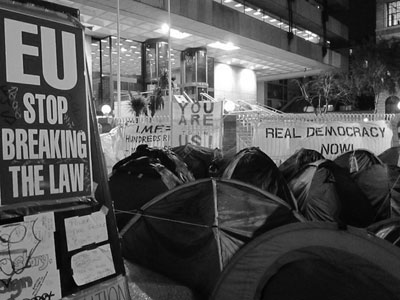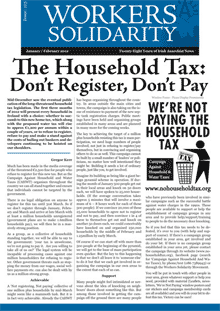Over 30 years of anarchist writing from Ireland listed under hundreds of topics
A quick introduction to Occupy Dame Street
 Over the last year, from Tahrir Square in Cairo to New York, a new movement sprung from the discontent of millions. It brought down a dictatorship in Egypt, re-awakened the libertarian spirit in Spain and affected a sea change in American politics. The Occupy movement, as it has become popularly known in English speaking countries, shook the world in 2011.
Over the last year, from Tahrir Square in Cairo to New York, a new movement sprung from the discontent of millions. It brought down a dictatorship in Egypt, re-awakened the libertarian spirit in Spain and affected a sea change in American politics. The Occupy movement, as it has become popularly known in English speaking countries, shook the world in 2011.
Based upon the idea that the 99% should control the world’s wealth and reviving the method of direct democracy, it struck fear into the hearts of the ruling 1%. Very few people, however, believed that such a movement could spread to Ireland. The Irish, after all, don’t protest.
Even when a group calling themselves Occupy Dame Street (ODS) acted upon their intention to set up camp in front of the Central Bank on October 8th last, many people believed the protest would be over within the night. No one, even the most determined of the campers, thought they would still be there when the frost hit in December.
The occupation began with three central demands: that the European Central Bank and the International Monetary Fund stay out of Irish affairs and the debt be lifted; that the oil and gas reserves off the Irish coast be returned to “sovereign” control and finally, crucially, that we implement “real participatory democracy - where the people’s interests come first, where the people decide what happens”.
It was in the pursuit of this last demand that ODS provided a practical example. From the outset, general assemblies (GAs) were held twice a day (later reduced to once a day) where decisions affecting the movement could be made. Decisions were made by consensus rather than by majority vote.
At first GA’s were badly organised but the creation of a facilitation working group helped refine the process. Within weeks GA’s were getting through several proposals per session. Protests were organised and policy was altered, all through a process of collective decision-making.
The consensus process that successfully prevented groups or political parties from packing assemblies to further their own ends also caused some problems. A proposal to work with the Dublin Congress of Trade Unions (DCTU) to organise a march was blocked at a GA by a small number of people. This created a rift and some people went on to do this work on their own.
This proved to be a turning point for ODS as attendances at GA’s fell, but those who stayed around did not lose their enthusiasm. A series of direct actions were undertaken, including human microphones or “mic checks” at banks around the city. People from ODS also took part in the recent Union of Students in Ireland demonstration and the Spectacle of Defiance and Hope.
As ODS heads towards its third month, the heady enthusiasm of October may have waned but the resolve of the occupiers has not. They will continue to camp and organise protests for the foreseeable future. But the most important contribution of ODS to the Irish political landscape may be its influence on other protests.
The idea of occupation has taken firm root among those aiming to force a change in government policy on a wide range of issues. Student groups have occupied TDs’ offices and government departments, as did protesters on budget day. As the winter continues and camping becomes less and less of an attractive prospect, indoor occupations could take the movement forward and provide spaces for assemblies and organising protest.
Whatever the fate of ODS, there is no doubt that those who were brave enough to pitch their tents at “Liberty Plaza” on the eighth of October have altered the popular imagination when it comes to protest. ODS in isolation will never achieve its core demands but it has drawn a new layer of people into political activity who had never considered it before and it has popularised the ideas of direct democracy and occupation. For that it must be considered a success.
This article is from Workers Solidarity 125, Jan/Feb 2012

